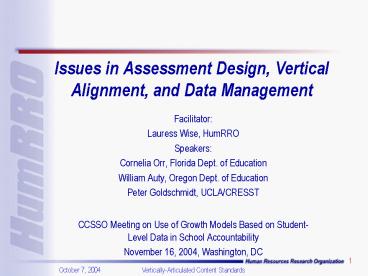Issues in Assessment Design, Vertical Alignment, and Data Management PowerPoint PPT Presentation
1 / 13
Title: Issues in Assessment Design, Vertical Alignment, and Data Management
1
Issues in Assessment Design, Vertical Alignment,
and Data Management
- Facilitator
- Lauress Wise, HumRRO
- Speakers
- Cornelia Orr, Florida Dept. of Education
- William Auty, Oregon Dept. of Education
- Peter Goldschmidt, UCLA/CRESST
- CCSSO Meeting on Use of Growth Models Based on
Student-Level Data in School Accountability - November 16, 2004, Washington, DC
2
Assessment Design, Vertical Alignment, and Data
Management
- Some Key Questions for Presenters and Discussants
(You in the Audience!) - Assessment Design
- How well do the assessments at each grade cover
targeted content standards? - How are the assessments related across grades?
- Vertical Alignment
- How are the content standards related across
grades? - What does a vertical growth scale measure?
- Data Management
- Can data on individual students be tracked across
time?
3
Growth Scales Need Vertical Alignment
4
What Is Vertical Alignment?
- Vertical alignment asks
- How are content standards/objectives related from
one grade to the next? - Knowledge or skills extended to wider range of
content - Deeper understanding (cognitive processes) for
the same content - New or different content and/or skills
5
TILSA Work onVertical Alignment
- Initial focus on supporting vertical scales
- Is content alignment sufficient to justify a
vertical scale? - How to label points along the vertical scale?
- Changed to focus on quality of vertical
articulation - Concerns about misuse of vertical scales
- Inferences about mastery of content not tested
- Scales will vary by content of items used in
linking - Other important needs for clarifying content
standards and their relationship across grades - Helping teachers talk across grades
- Clarifying test specifications within each grade
- Supporting the development of curriculum materials
6
Nature of Content Alignment
- Applying Webbs Alignment constructs
- Categorical Concurrence
- What content is new? What content is continued?
- Range of Content
- Broadening or generalizing knowledge/skills
- Depth of Knowledge (DOK)
- Webb DOK ratings are somewhat grade-specific.
- Balance of Representation
- How does content emphasis vary across grades?
- Source of Challenge
- What needs to be clarified about the standards?
7
Quality of Content Alignment
- Content standards are not clearly articulated
across grades if - Related standards are not clearly differentiated.
- What new knowledge or skill is required?
- One or both standards may not be described in
sufficient detailed. - Differences in terminology are not explained.
- Different words for the same skill?
- Terminology drifts.
- The meaning of terms appears to be expanded.
- Specific objectives are omitted at some grade.
8
Gathering Content Alignment Data
- Who should judge?
- Same experts who developed the content
frameworks. - What are judges asked to do?
- Make judgments about individual standards.
- Grade-to-grade comparisons (summed up later)
- Within specific content areas or subscales
- To limit search for similar standards
- Identify related prior-grade standard(s)
- Describe relationship
- Qualitative description of what is new or added.
- Code relationship type (Extend, Deeper, New,
Same, Prerequisite) - Identify quality issues
- Source(s) of challenge
9
Reporting Vertical Alignment
- Detailed reports
- Content Maps
- List of specific challenges (articulation quality
concerns) - Summary indicators
- Concurrence - new content
- Range - of skills broadened
- Depth - of skills deepened
- Balance - of standards with few/many objectives
- Challenge Average rating flagged with
comments
10
Simplified Content Map
11
Next Steps in TILSAs Vertical Alignment Work
- Complete concept paper for the current project.
- Identify opportunities for further pilot work.
- Improve data collection protocols.
- Develop/improve rater training.
- Build detailed examples of reports.
- Begin to talk about more specific standards for
good vertical alignment.
12
Questions about Vertical Scales for your
Psychometricians
- How well can performance on unique material at
each grade be predicted by the common scale? - How limiting are assumptions of a unidimensional
scale? - Example If math content at one grade emphasizes
calculation while content at the next grade
emphasizes problem solving, - what does the growth scale measure?
- Is the lower grade score an adequate pre-test
for growth at the next grade? - How stable are the cross-grade linkages across
time?
13
Useful References for Vertical Scaling
- Specific to Vertical Scaling
- Schulz, E.M. Nicewander, A. (1997). Grade
equivalent and IRT representations of growth.
Journal of Educational Measurement, 34(4),
315-332. - Yen, W. M. Burket, G.R. (1997). Comparison of
item response theory and Thurstone methods of
vertical scaling. Journal of Educational
Measurement, 34(4), 293-314. - Camilli, G. (1999). Measurement error,
multidimensionality, and scale shrinkage a reply
to Yen and Burket. Journal of Educational
Measurement, 36(1), 73-78. - Williams, V.S.L., Pommerich, M. Thissen, D.
(1998). A comparison of developmental scales
based on Thurstone methods and item response
theory. Journal of Educational Measurement,
35(2), 93-107. - More General References on Equating
- Kolen, M.J. Brennan, R.L. (1995). Test
Equating Methods and Practices. New York
Springer. - Peterson, N.S., Kolen, M.J., Hoover, H.D.
(1989). Scaling, norming and equating. In Linn,
R.L. (Ed.) Educational Measurement, 3rd Edition.
New York American Council on Education and
Macmillan. - Lord, F.M. (1980). Applications of Item Response
Theory to Practical testing Problems. Hillsdale,
NJ Lawrence Erlbaum Associates.

